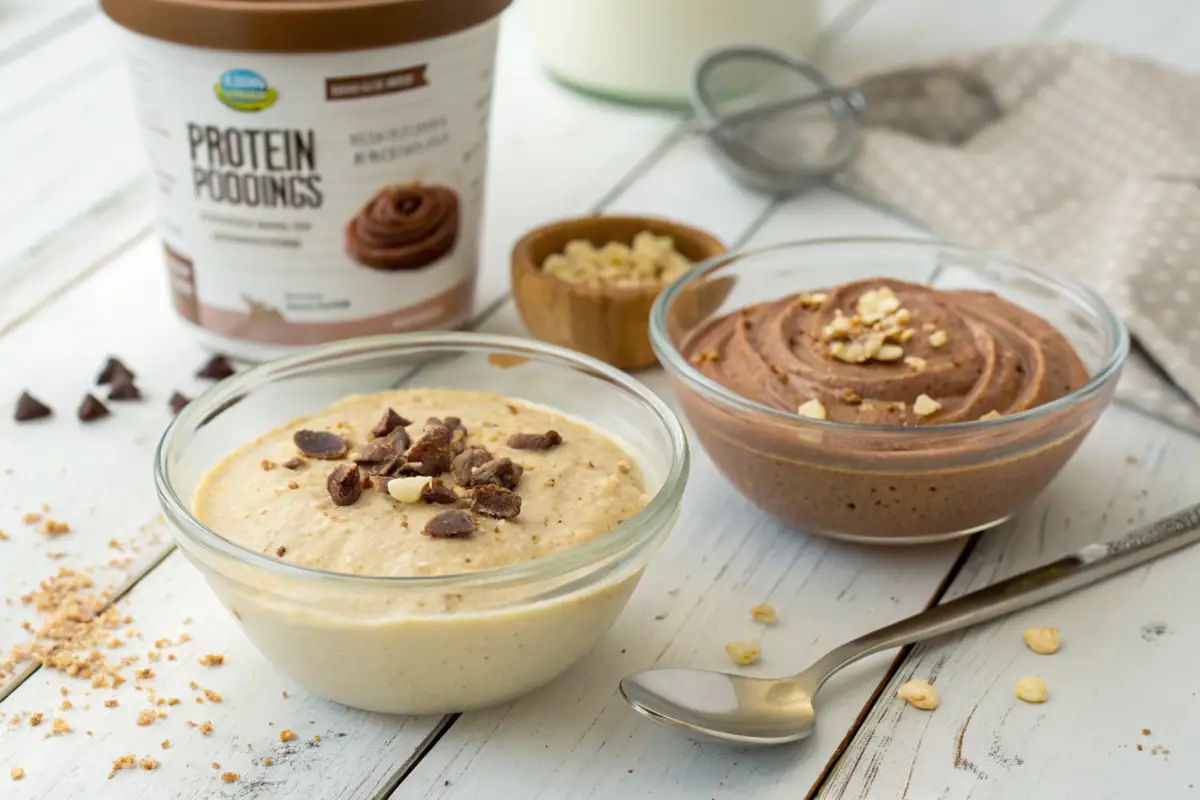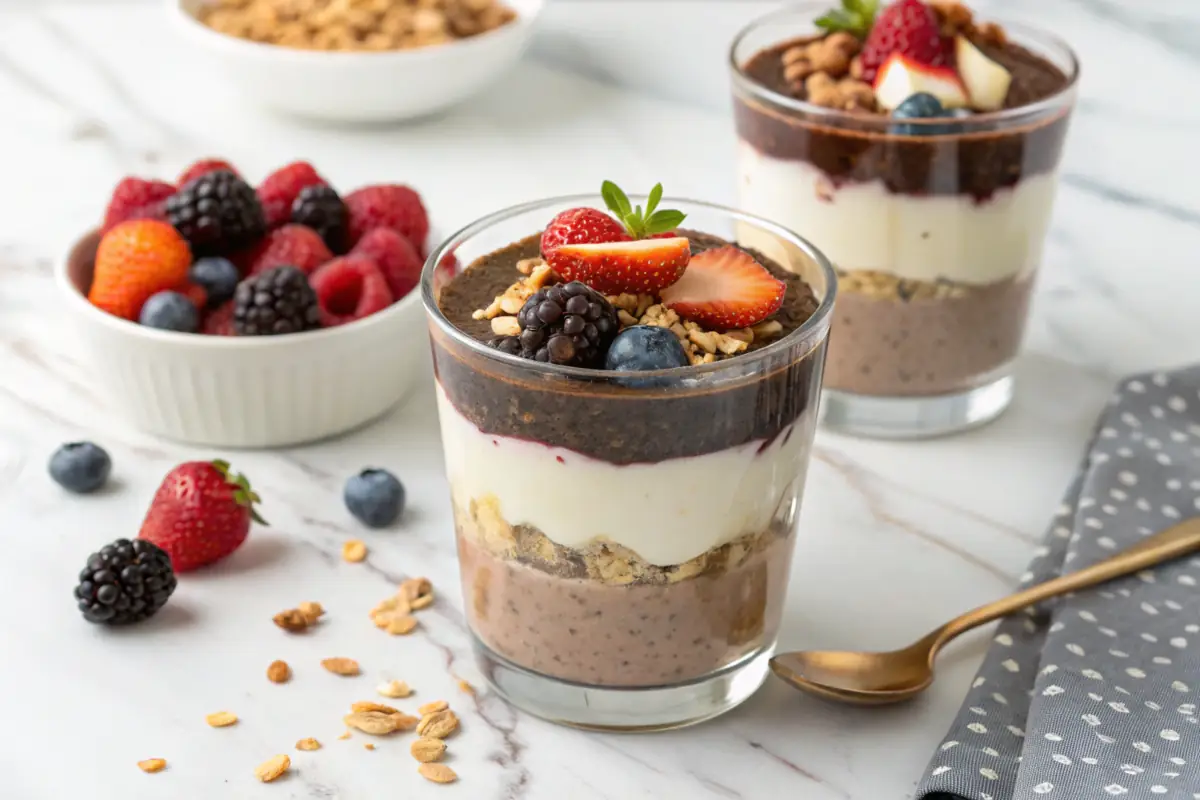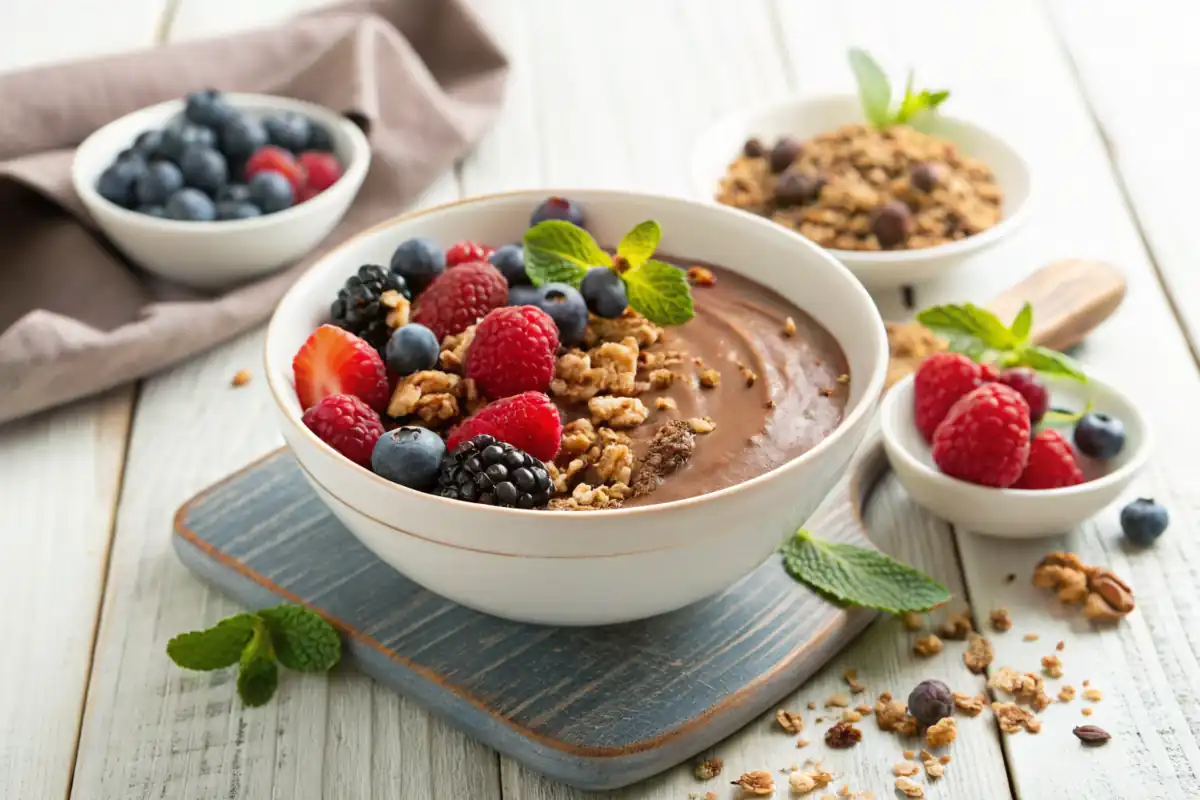Protein puddings are gaining popularity as a guilt-free treat that combines indulgence with nutrition. But are protein puddings healthy? Packed with protein and marketed as low-sugar, high-protein snacks, these puddings promise to satisfy cravings while supporting fitness goals. However, understanding their benefits and drawbacks is essential to decide if they’re truly a good addition to your diet.
What Are Protein Puddings?
Introduction to Protein Puddings
Protein puddings are a delightful fusion of dessert and health-conscious snacking. Typically, they’re made with high-protein ingredients like whey, casein, or plant-based protein powders. Many brands aim to deliver a low-calorie, low-carb, and low-fat alternative to traditional desserts. These puddings come in a variety of flavors, from classic chocolate and vanilla to exotic combinations like salted caramel or berry medleys.
The concept of protein puddings evolved to cater to fitness enthusiasts and health-conscious individuals looking for a nutritious yet indulgent snack. Their creamy texture, coupled with the promise of muscle recovery and satiety, has made them a staple in many diets.
Varieties of Protein Puddings
Protein puddings are as versatile as they are tasty. You can find two main types:
- Ready-to-Eat Options
Pre-packaged protein puddings are widely available in stores. They’re convenient, shelf-stable, and perfectly portioned. Popular brands include ones that cater to specific dietary needs, such as gluten-free, lactose-free, or low-sugar options. - Homemade Alternatives
On the flip side, making protein puddings at home allows for complete control over ingredients. Common bases include Greek yogurt, cottage cheese, or almond milk, combined with protein powders and natural sweeteners like maple syrup or stevia. This option often proves to be more cost-effective and customizable.
Whether store-bought or homemade, protein puddings can satisfy your sweet tooth while aligning with fitness goals. Next, let’s take a closer look at their nutritional profile to see what’s really inside these creamy delights.
Nutritional Profile of Protein Puddings
Protein Content and Its Benefits
When considering the question Are protein puddings healthy?, the first thing to examine is their protein content. Protein puddings are crafted to deliver a high-protein punch in a convenient format. For instance, most commercial options boast 10 to 20 grams of protein per serving, derived from sources like whey, casein, or plant-based proteins.
Why does this matter? Protein is crucial for muscle repair, satiety, and maintaining overall energy levels. Compared to traditional desserts, protein puddings provide nutrient-dense satisfaction without the usual sugar overload, making them a smart choice for post-workout recovery or as a mid-day snack.
Macronutrient Balance
Protein puddings also stand out for their overall macronutrient profile. Typically low in fat and carbohydrates, they align well with diets such as low-carb or high-protein plans. However, not all protein puddings are created equal. Some may include hidden sugars or fillers to enhance flavor, which can increase caloric content.
To make a healthier choice, always check the nutrition label. Opt for varieties with balanced fats and minimal artificial additives. Homemade protein puddings can give you greater control over macronutrient distribution, allowing you to cater to specific dietary needs.
Additives and Artificial Ingredients
A potential drawback of store-bought protein puddings is the use of additives. Thickeners, artificial sweeteners, and preservatives often enhance texture and shelf life. While these ingredients are generally safe, consuming them in excess could lead to digestive discomfort or unwanted side effects.
For those seeking natural options, homemade recipes, like this guide to protein pudding preparation, allow you to eliminate these additives entirely.
Health Benefits of Protein Puddings
Support for Fitness Goals
One of the most touted benefits of protein puddings is their ability to support fitness goals. They’re a perfect blend of indulgence and functionality, offering muscle recovery benefits post-workout. High-protein snacks like these can also curb appetite, making them effective for weight loss or maintenance strategies.
Moreover, their low-carb and low-fat composition makes them a hit among keto enthusiasts and those following a macro-conscious lifestyle. Whether as a meal replacement or an energy-boosting snack, protein puddings provide a versatile solution.
Convenience and Versatility
In today’s fast-paced world, convenience is king. Protein puddings are quick to prepare (or grab on the go) and can double as a healthy dessert or nutritious snack. Homemade options allow you to experiment with personalized flavors by adding fruits, nuts, or granola.
Their versatility doesn’t end there. Protein puddings can easily be transformed into layered parfaits or used as a topping for smoothie bowls. The possibilities are endless, making them a creative addition to any diet.
Incorporating protein puddings into your routine can be a tasty, functional way to meet dietary goals. But, as with any food, moderation and mindfulness are key. Up next, we’ll explore the potential drawbacks and risks associated with these trendy snacks.
Potential Drawbacks and Risks
Excessive Protein Intake
When asking Are protein puddings healthy?, it’s essential to consider the potential risks of consuming too much protein. While protein is vital for bodily functions, excessive intake can lead to issues like kidney strain or digestive discomfort. For those with pre-existing kidney conditions, it’s crucial to limit high-protein snacks like these to avoid potential harm.
Additionally, consuming protein puddings in place of balanced meals may lead to nutrient gaps. They are not a substitute for a well-rounded diet, and over-reliance can disrupt nutritional balance.
Sugar and Sweeteners
Another drawback lies in the hidden sugars and artificial sweeteners found in some store-bought protein puddings. While marketed as low-sugar options, many use ingredients like sucralose or aspartame to enhance flavor. These sweeteners, though calorie-free, can sometimes lead to cravings or digestive upset.
Homemade puddings allow you to avoid these additives entirely. Using natural sweeteners like honey or maple syrup can make for a healthier alternative. For recipes that skip artificial ingredients, check out this protein pudding recipe guide.
Lactose and Allergen Concerns
Many protein puddings are dairy-based, making them unsuitable for individuals with lactose intolerance or dairy allergies. While some brands offer plant-based alternatives, they may not provide the same creamy texture or taste. Always read labels carefully to ensure the product aligns with your dietary restrictions.
For those with allergies, homemade versions using almond milk, coconut milk, or soy milk can offer a safe and delicious solution.
Comparing Store-Bought vs. Homemade Protein Puddings
Nutritional Differences
Store-bought protein puddings are a convenient option but may come with added preservatives, stabilizers, or artificial flavors. These ingredients, while harmless in moderation, might not align with everyone’s health goals. On the other hand, homemade protein puddings offer complete control over what goes into your treat.
Using fresh, whole ingredients like Greek yogurt or chia seeds ensures a cleaner, nutrient-rich dessert. Homemade options also let you customize the sweetness and protein content to fit your preferences.

Cost-Effectiveness
Price is another factor when comparing store-bought and homemade puddings. Pre-packaged options often come at a premium, especially for brands offering specialized diets like gluten-free or keto. Homemade puddings, however, are typically more budget-friendly. Ingredients like protein powder and non-dairy milk can be purchased in bulk, reducing overall costs.
For a creative twist on homemade puddings, try adding fruit layers or granola for added texture and flavor. You can find inspiration in this protein pudding recipe guide, which offers innovative ideas for customizing your puddings.
Store-bought protein puddings may be practical for busy days, but homemade versions provide a wholesome, cost-effective alternative. With the ability to tailor ingredients to your needs, homemade puddings are often the healthier and more satisfying choice.
Popular Recipes and Brands
Homemade Protein Pudding Recipes
Homemade protein puddings are not only customizable but also offer a fresh, additive-free alternative to store-bought options. With just a few ingredients, you can whip up a delicious and nutritious treat in minutes. Popular bases include Greek yogurt, cottage cheese, or non-dairy alternatives like almond or coconut milk.
For example, a simple chocolate protein pudding can be made with cocoa powder, protein powder, and a natural sweetener like honey or stevia. Add a sprinkle of chia seeds for extra fiber and omega-3s. Layering your pudding with fresh berries or granola can elevate it to a visually stunning dessert. The possibilities are endless, making homemade options ideal for both health-conscious eaters and creative cooks.

Top Brands in the Market
For those who prefer convenience, store-bought protein puddings come in a variety of flavors and formulations. Brands like Premier Protein, Koia, and SimplyProtein cater to diverse dietary needs, offering options that are low-carb, gluten-free, or plant-based. These puddings are often packaged in single-serving portions, making them perfect for on-the-go snacking.
However, not all brands are created equal. Some may include hidden sugars, artificial flavors, or preservatives, so it’s essential to read the nutrition label carefully. When in doubt, compare the macronutrient profiles to find an option that aligns with your dietary goals.
FAQs About Protein Puddings
Is Protein Pudding Good for Weight Loss?
Yes, protein pudding can support weight loss, especially when used as a low-calorie, high-protein snack. It helps keep you full and curbs cravings, making it easier to stick to a calorie deficit. However, always choose varieties with minimal added sugars and fats.
Can You Eat Protein Pudding Every Day?
In moderation, protein pudding can be a healthy daily snack, but it shouldn’t replace whole, balanced meals. Over-relying on it may lead to nutrient deficiencies since it lacks the fiber, vitamins, and minerals found in whole foods.
What Is the Best Time to Eat Protein Pudding?
The best time to enjoy protein pudding is post-workout, as it supports muscle recovery. It also makes a great mid-day snack to sustain energy levels or as a healthy dessert option.
How to Choose a Healthy Protein Pudding?
Look for puddings with high protein content, minimal sugar, and natural ingredients. Avoid those with long lists of artificial additives or unnecessary fillers. Homemade options are often the healthiest choice.
Final Thoughts: Are Protein Puddings Worth It?
Balancing Benefits and Risks
When it comes to answering Are protein puddings healthy?, the verdict largely depends on how they fit into your overall diet. Protein puddings provide a nutritious, convenient, and versatile option, especially for those with busy lifestyles or specific fitness goals. Their high protein content supports muscle recovery, while low sugar and fat varieties can align with weight loss or maintenance plans.
However, it’s essential to balance their benefits with potential risks. Overconsumption or reliance on protein puddings can lead to nutritional imbalances. Opting for homemade versions or carefully choosing store-bought options with natural ingredients can help you avoid common pitfalls like excessive additives or hidden sugars.
Personalizing Your Approach
Ultimately, whether protein puddings are a healthy choice for you depends on your personal dietary needs and goals. If you enjoy their taste and find them helpful in reaching your nutritional targets, they can be a valuable addition to your routine. On the other hand, if you’re concerned about allergens, additives, or cost, consider preparing them at home.
For a balanced approach, use protein puddings as part of a varied and nutrient-rich diet. Combine them with whole foods like fruits, vegetables, and whole grains to ensure you’re meeting all your nutritional needs.

